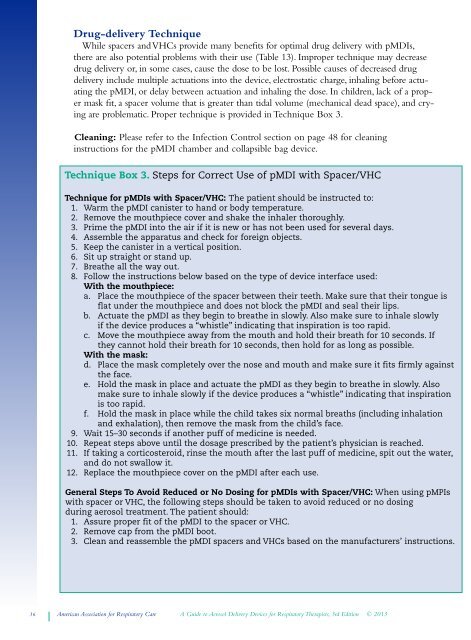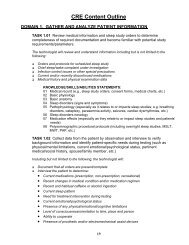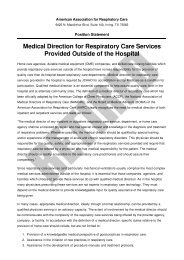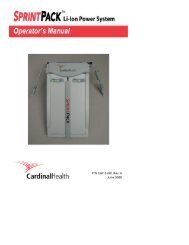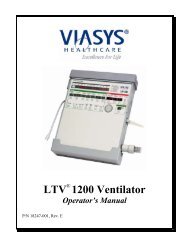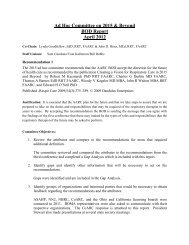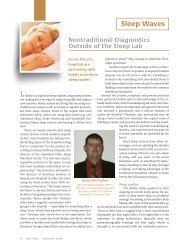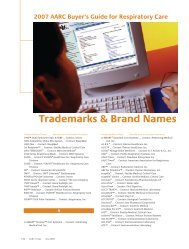Aerosol Guide - AARC.org
Aerosol Guide - AARC.org
Aerosol Guide - AARC.org
You also want an ePaper? Increase the reach of your titles
YUMPU automatically turns print PDFs into web optimized ePapers that Google loves.
Drug-delivery Technique<br />
While spacers and VHCs provide many benefits for optimal drug delivery with pMDIs,<br />
there are also potential problems with their use (Table 13). Improper technique may decrease<br />
drug delivery or, in some cases, cause the dose to be lost. Possible causes of decreased drug<br />
delivery include multiple actuations into the device, electrostatic charge, inhaling before actuating<br />
the pMDI, or delay between actuation and inhaling the dose. In children, lack of a proper<br />
mask fit, a spacer volume that is greater than tidal volume (mechanical dead space), and crying<br />
are problematic. Proper technique is provided in Technique Box 3.<br />
Cleaning: Please refer to the Infection Control section on page 48 for cleaning<br />
instructions for the pMDI chamber and collapsible bag device.<br />
Technique Box 3. Steps for Correct Use of pMDI with Spacer/VHC<br />
Technique for pMDIs with Spacer/VHC: The patient should be instructed to:<br />
1. Warm the pMDI canister to hand or body temperature.<br />
2. Remove the mouthpiece cover and shake the inhaler thoroughly.<br />
3. Prime the pMDI into the air if it is new or has not been used for several days.<br />
4. Assemble the apparatus and check for foreign objects.<br />
5. Keep the canister in a vertical position.<br />
6. Sit up straight or stand up.<br />
7. Breathe all the way out.<br />
8. Follow the instructions below based on the type of device interface used:<br />
With the mouthpiece:<br />
a. Place the mouthpiece of the spacer between their teeth. Make sure that their tongue is<br />
flat under the mouthpiece and does not block the pMDI and seal their lips.<br />
b. Actuate the pMDI as they begin to breathe in slowly. Also make sure to inhale slowly<br />
if the device produces a “whistle” indicating that inspiration is too rapid.<br />
c. Move the mouthpiece away from the mouth and hold their breath for 10 seconds. If<br />
they cannot hold their breath for 10 seconds, then hold for as long as possible.<br />
With the mask:<br />
d. Place the mask completely over the nose and mouth and make sure it fits firmly against<br />
the face.<br />
e. Hold the mask in place and actuate the pMDI as they begin to breathe in slowly. Also<br />
make sure to inhale slowly if the device produces a “whistle” indicating that inspiration<br />
is too rapid.<br />
f. Hold the mask in place while the child takes six normal breaths (including inhalation<br />
and exhalation), then remove the mask from the child’s face.<br />
9. Wait 15–30 seconds if another puff of medicine is needed.<br />
10. Repeat steps above until the dosage prescribed by the patient’s physician is reached.<br />
11. If taking a corticosteroid, rinse the mouth after the last puff of medicine, spit out the water,<br />
and do not swallow it.<br />
12. Replace the mouthpiece cover on the pMDI after each use.<br />
General Steps To Avoid Reduced or No Dosing for pMDIs with Spacer/VHC: When using pMPIs<br />
with spacer or VHC, the following steps should be taken to avoid reduced or no dosing<br />
during aerosol treatment. The patient should:<br />
1. Assure proper fit of the pMDI to the spacer or VHC.<br />
2. Remove cap from the pMDI boot.<br />
3. Clean and reassemble the pMDI spacers and VHCs based on the manufacturers’ instructions.<br />
36 American Association for Respiratory Care A <strong>Guide</strong> to <strong>Aerosol</strong> Delivery Devices for Respiratory Therapists, 3rd Edition © 2013


